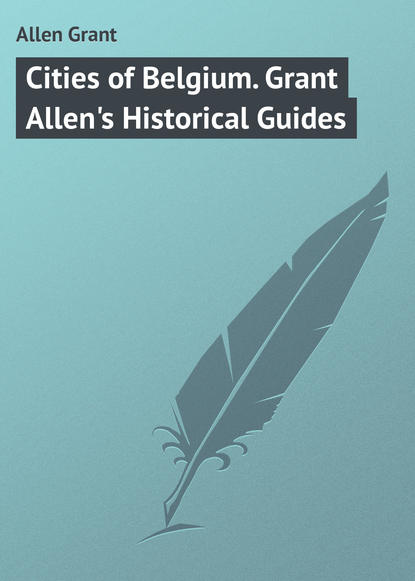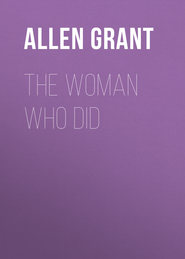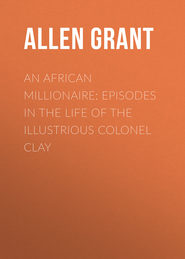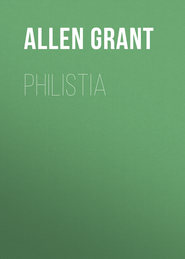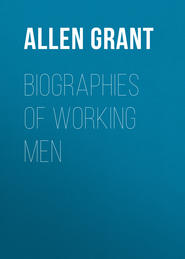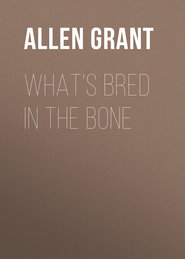По всем вопросам обращайтесь на: info@litportal.ru
(©) 2003-2024.
✖
Cities of Belgium. Grant Allen's Historical Guides
Настройки чтения
Размер шрифта
Высота строк
Поля
Above these, 109, a triptych, by Coninxloo. Centre, Family of St. Anne. Interesting for comparison with the great Quentin Matsys in the centre of the room. L., Joachim’s offering rejected in the Temple (small episodes behind). R., the death of St. Anne. Come back to the central panel after you have viewed the Quentin Matsys. (The component personages are explained there.)
543. Tolerable triptych, Flemish school, representing the events of the Infancy. Centre, Adoration of the Shepherds, with the usual conventional features (ruined temple, shed, ox and ass, etc.), and St. Joseph holding his candle, as often, to indicate night time. Left, Annunciation, with the usual position of the angel reversed. Otherwise, the portico and other features persist. Compare the great Van Eyck at Ghent, from which some elements here are borrowed. Right, the Circumcision. Symbolical figure of Moses on altar, full of the symbolism of Van der Weyden’s school. (Outer shutters, uninteresting, SS. Catharine and Barbara.)
585. Above it, good family group of a donor and his sons, with St. George; and his wife and daughters, with St. Barbara. (The crucifixes mark monks and nuns.)
At the corner, 624, German school. St. Mary Magdalen and St. Thomas, on gold background. Companion piece to 624. At opposite end.
626. School of Martin Schongauer: Christ and the Magdalen in the house of the Pharisee. Very contorted. Compare with the Gossart.
Above it, 106, Flemish school. Mass of St. Gregory, with the Crucified Christ appearing on the altar. (Recall the Pourbus at Bruges.) A most unpleasant picture. Behind, are the elements of the Passion. L., the donors; R., Souls in Purgatory, relieved by masses. Many minor episodes occupy the area.
On either side of it, *27, 28, beautiful soft-toned German portraits (? by Beham) of two children, Maximilian II. and his sister Anne of Austria.
563. Lombard: Unimportant picture, meaninglessly described as Human Misfortunes. It seems to commemorate an escape from shipwreck and from plagues by the same person. L. panel: A ship sinking; a man saved on the shore. In the background, under divine direction of an angel, he finds his lost gold in a fish’s body. R. panel, He lies ill of plague, while above is seen the miracle of St. Gregory and the Angel of the Plague (Michael) sheathing his sword on the Castle of St. Angelo.
540. Virgin and Child. Attributed without much certainty to Petrus Christus.
535. Good unknown Flemish picture of the *Assumption of Our Lady (closely resembling No. 534, which see again). The empty tomb stands in the midst, with lilies; around, St. Peter and St. James, and the other apostles; above, Our Lady ascending, borne by a duplicated figure of Christ (one standing for the Holy Ghost), in an almond-shaped glory. R., Her Funeral, with St. Peter wearing the triple crown; L., St. Thomas receiving the girdle from an angel. Compare with 534, which Lafenestre judges to be the work of a different artist.
567. Good portrait attributed to Bernard Van Orley.
596. Six panels: Flemish School. Ornate, but not interesting. (1) The Lord creating Eve; in the background the Temptation. (2) Abraham, Sarah, and Isaac; in the background in three successive scenes, Abraham’s Sacrifice. (3) Noah and his Family with the Ark. (4) Esau asks the Blessing of Isaac. (5) Meeting of Jacob and Esau. Note the grotesquely urban conception of the Semitic nomads. (6) The Nativity.
559. Attributed to Van Orley. Pietà, with the usual group, and family of donors. Interesting as a work of transition.
Above it, 580. Triptych, with Descent from the Cross, Flemish school. Usual figures; identify them. On the wings, L., Agony in the Garden, Kiss of Judas, Peter and Malchus: R., The Resurrection. Noli Me Tangere, Disciples at Emmaus, etc.
107. P. Coecke, 16th century: A Last Supper. Only interesting as showing transition. Compare with Dierick Bouts.
Above it, 300. Patinier: Dead Christ on the knees of the Virgin (Our Lady of the Seven Sorrows), painfully emaciated. A sword pierces Our Lady’s breast (and will recur often). Around it, the rest of the Seven Sorrows. Note the landscape, characteristic of the painter.
12. (Old number; no new number.) Coninxloo: Joachim and Anna, with the rejected offering. From them, a genealogical tree bears the Madonna and Child. L. and R., the Angel appearing to Joachim, and Joachim and Anna at the Golden Gate. (Read up the legend.) Curious architectural setting.
301. Good portrait by an unknown (transitional) Fleming (Van Orley?), probably of a lawyer; the charters seem to indicate a secretary of Maximilian and Charles V.
The place of honour in the centre of the room is occupied by 299, a magnificent **triptych by Quentin Matsys, one of the noblest works of the transitional school, strangely luminous, with very characteristic and curious colouring. It represents the favourite Flemish subject of the Family of St. Anne. (It was painted for the Confraternity of St. Anne at Louvain, and stood as an altar-piece in the church of St. Pierre.) Central panel: An arcade, in the middle arch of which appears St. Anne, in red and purple (throughout), offering grapes to the Divine Child, who holds a bullfinch, and is seated on the lap of Our Lady. R., Mary Salome, with her two sons James and John. L., Mary Cleophas, with her sons James the Less, Simon, Thaddæus, and Joseph the Just. Behind the parapet, beside St. Anne, her husband Joachim; and beside Mary Salome, her husband Zebedee. Beside Our Lady, her husband Joseph; beside Mary Cleophas, her husband Alphæus. Beautiful blue mountain landscape. L. panel: The angel appearing to Joachim, in a magnificent blue landscape. Joachim’s dress is constant. The angel’s robe is most delicious in colour. R. panel: The Death of St. Anne, with Our Lady and the other Maries in attendance. Behind, their husbands. The young Christ gives the benediction.
Now, go round to the back of the picture, to observe the outer wings. L., St. Joachim driven from the Temple by the High Priest R. (chronologically the first), Joachim and Anna (much younger), making their offerings (on marriage) to the High Priest in the Temple. (Same High Priest, younger; same dresses.) The portrait behind recalls the earlier Flemish manner; otherwise, the work is full of incipient transition to the Renaissance. Little episode of Joachim and Anna distributing alms in the background. (When the triptych is closed, this wing comes in its proper place as first of the series.)
191. Jan van Eyck: (attribution doubtful; probably a later artist, perhaps Gerard David): The Adoration of the Magi. Another good example of this favourite Flemish subject. In the foreground, the Madonna and Child: one of Van Eyck’s most pleasing faces (if his). Then, the Old King, kneeling; the Middle-aged King, half-kneeling; and the Young King, a Moor, with his gift, behind. (The Old King in such pictures has almost always deposited his gift.) In the background, Joseph, and the retinue of the Magi. Ruined temple, shed, ox, ass, etc., as usual.
291. Dierick Bouts: *Martyrdom of St. Sebastian. Characteristic peasant face; admirable cloak and background.
Now go into the next hall, marked
Room II
on the plan. This contains mainly German and Flemish pictures of the transition.
Right of the door, 338. Very Raphaelesque Holy Family by Bernard Van Orley, showing in the highest degree the Italian influence on this originally quite Flemish painter.
Above it, 92 and 92A. Portraits of the Micaul family.
105. J. Joest: St. Anne enthroned, Joseph, Our Lady, the Infant. Early transitional.
193. Jean Gossaert, Adam and Eve. Good later Flemish nude.
50. J. Bosch: Appalling Flemish Temptation of St. Anthony, with perhaps the silliest and most grotesquely repulsive devils ever painted.
2. Aertsen: *The Dutch Cook. A famous picture, showing well the earlier stages of Dutch genre development.
217. Van Hemessen: Genre piece, absurdly given the name of The Prodigal Son, by a sort of prescription, but really a Flemish tavern scene of the sort which afterwards appealed to Dutch artists. A characteristic work: transitional, but with good humorous faces, especially to the right. Painters still thought all pictures must pretend to be sacred.
591. German Adoration of the Magi. A fragment only.
603. Herri met de Bles: The Temptation of St. Anthony. Figures and landscape show Italian influence.
336. Transitional Adoration of the Shepherds. Observe the growing Renaissance feeling and Italian influence.
247, 248. Excellent portraits by Adrien Key.
41. Lancelot Blondeel: St. Peter enthroned as Pope: in one of his usual extravagant architectural frameworks. In circles above, his Imprisonment and Crucifixion.
Close by, unnumbered, two excellent portraits.
81. P. Brueghel the Younger: absurdly called The Census at Bethlehem. In reality a Flemish winter scene.
318. Sir Anthony More: *Portrait of the Duke of Alva, with the firm lips and cruel eyes of the ruthless Spaniard. One understands him.
359. Good portrait by Pourbus of a plump and well-fed Flemish gentleman.
80. P. Brueghel the Younger: Described as the Massacre of the Innocents. Flemish winter. The beginning of genre painting.
Most of the pictures skied above these are of some interest for comparison with earlier examples of the same subjects.
565. Unknown French portrait of Edward VI. of England. Hard and dry and of little artistic value.
566. Tolerable Flemish portrait of Guillaume de Croy (Golden Fleece).
573. Good Flemish portrait of a woman, dated 1504.
555. Flemish school: Annunciation. Chiefly interesting for its conventional features, and its very quaint figure of St. Mary of Egypt, with her three loaves, in the R. panel.
124b. (Old number; no new number given.) Unusual combined picture of St. Jerome, uniting the subjects usually known as St. Jerome in the Desert and St. Jerome in his Study.
622. Fine German portrait of the early 17th century.
316. Good strong portrait, by Sir Anthony More, of Hubert Goltzius.





